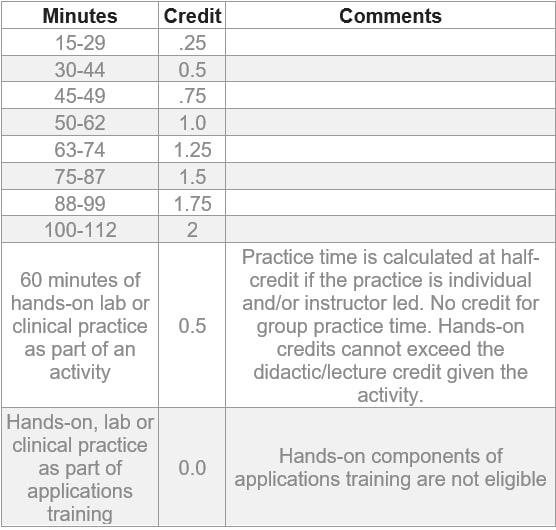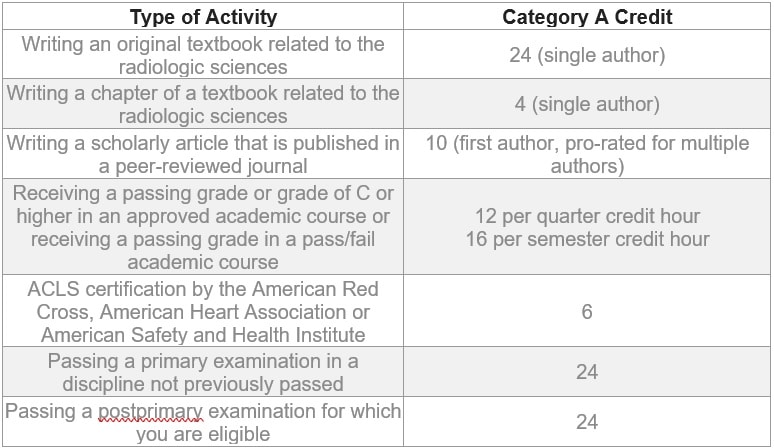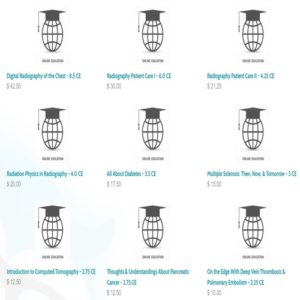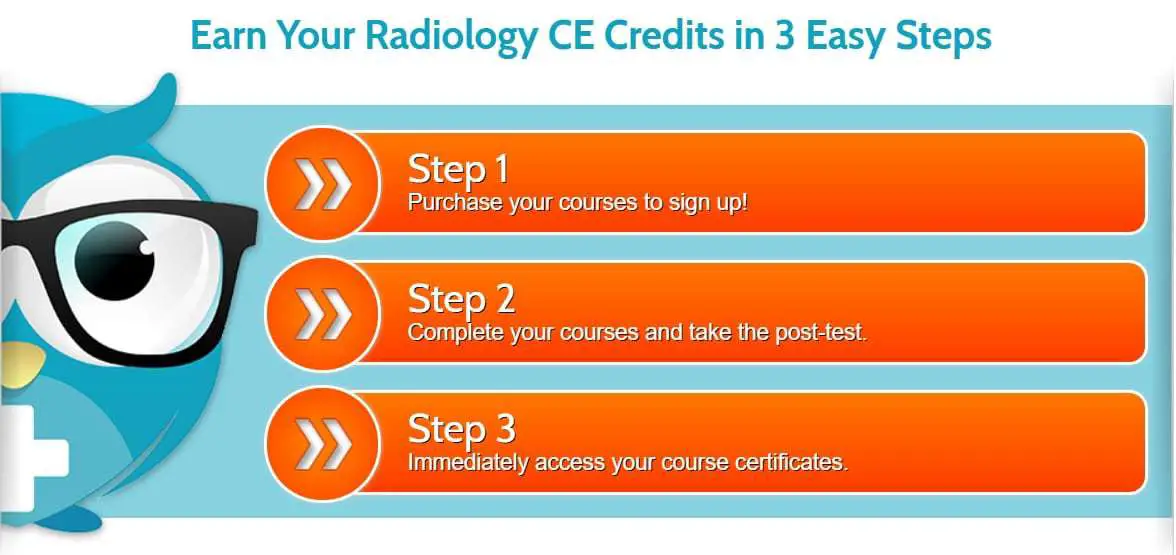What Continuing Education Units must radiology technologists get for their professional license?
Continuing educational units, CEUs or CEs, units of measure to an educational presentation. Earn these credits by attending classes or seminars in person or online, including relevant college coursework and conferences.
You can also complete educational modules in magazines approved by specific organizations. You must earn 24 CEUs every two years in radiography to keep your license current.
Continuing education credits serve the purpose of making sure a technologist attempts to keep their industry knowledge current. Medicine and technology advance at a very fast pace. Trying to learn the latest techniques and understand the newest advancements ensures you have the knowledge to offer top-notch patient care in your field. This is true for many professions and not just radiology.
Other healthcare credentials require continuing education: nurses, physicians, respiratory therapists, psychologists, social workers, etc. Continuing education units are one of the standard pillars that form a solid knowledge base for many professions.
How are Continuing Education Units Determined?
One credit for continuing education is awarded based on the time spent teaching the subject matter, typically between 50 and 60 minutes. That is why sometimes you hear the term “continuing education credit.” Activities shorter than 15 minutes are not deemed valid. The duration of self-learning activities, such as magazine modules, is determined by the time it takes to finish the module, excluding the post-test.
The content of the activity evaluates the relevancy of the material. For radiology credit, the ASRT says it must be “planned, organized and administered to enhance the professional knowledge and skills that a radiologic technologist uses to provide service to patients, the public or the medical profession.”
Check this helpful chart to demonstrate credits for various activity lengths from the ASRT:

What does NOT qualify as a continuing education credit?
Not all activities are eligible for CEU credit. They do not qualify if they are considered part of your job. Also, they do not qualify if they are irrelevant to the radiologic sciences. Activities that are NOT eligible for CEU credit include:
- Attendance at routine department meetings or staff meetings.
- Chart rounds, journal clubs, poster sessions, tours, and viewing exhibits.
- Elected office or committee appointments.
- Activities are not relevant to the practice of radiologic technology.
- Student x-ray bowls or similar competitions.
- Development of manuals related to work or professional responsibilities.
- Courses specific to the policies and procedures of an employer or an institution.
How many continuing education credits does a rad tech need?
None of you are a graduate of a radiography program, and you work in a state that does not require licensure. There are still four or five states left in the United States that haven’t figured out the importance of having mandated state licensure. The state license requires that you have a national license for the ARRT to practice.
The ARRT license is the gold standard in our field that shows the technologist went to an accredited program and completed an appropriate amount of clinical hours to be considered an expert. Idaho is one of these states lacking licensure, and I could spend hours telling you about horrible X-ray images I have seen from places of business that take advantage of this lack of licensure.
These places will hire non-licensed technologists because they don’t have to pay them as much as a licensed tech earns. Even worse, some of these places don’t even use unlicensed techs. They teach their office staff how to “push the button” and take X-rays of their patients. This leads to an abhorrent amount of radiation given to the patient without the staff knowing how much they gave the patient. Not to mention the repeated exams due to incompetence.
But at some point…
All states will hear their citizens asking for safe practices and join the movement to ensure everyone administering radiation knows what they are doing. To be a proper, licensed technologist, you must earn 24 CEUs every 24 months. These two years are called a biennium. Your biennium is assigned by the American Registry of Radiologic Technology and is linked to your birth month and the year of your initial ARRT examination. The biennium begins on the first day of your birth month and ends two years later on the last day of the month before your birth.
Radiologic technologists who have completed their first ARRT certification exam begin the mandatory CEU requirements on the first day of their next birth month after the exam. For example, a new technologist born in July who passes an initial certification exam in May 2011 begins their first CE biennium on July 1, 2011, and must report CE compliance with their ARRT renewal two years later in 2013. You are no longer required to stay current on CEUs once you officially retire from the profession.
Who determines what qualifies as a continuing education unit?
The governing body that administers the license for radiologic technologists is the Association for Registered Radiologic Technologists or ARRT. The ARRT has established guidelines on what constitutes a CEU for radiology professionals. Other regulating bodies may offer CE credit for completing additional primary or postprimary certification.
You need to check with the appropriate certification body for more information. For example, the American Registry of Diagnostic Medical Sonographers (ARDMS) has its continuing education unit for ultrasound technologists. But the ARDMS also recognized ASRT CEUs for their licensure requirements as well. ARMRIT, the American Registry of MRI Technologists works the same way. They require CEUs for continued licensure, offer their own courses, and recognize CEUs from other accrediting bodies.
For the most part, the American Society for Radiologic Technologists recognizes by all imaging organizations. The ASRT is where content providers send their lesson outlines for continuing education units approval. I have taught my local state society lectures over the past few years. I write up an outline for the lecture. It gets sent to the ASRT for approval. Once they deem it meets certain guidelines and approve the lecture, I can give it to conference attendees.
Where can I get continuing education units?
There are several places to earn continuing education units for radiology professionals. My favorite is by attending radiology conferences. A conference will generally have several educational sessions that teach one specific topic related to healthcare. I attended seven sessions per day for two days at my annual state conference. I earned 14 continuing education units for those two days. I’ll go again next year, which will satisfy my ARRT requirement. Plus, it is a tax write-off because CEUs are required for my job.
Every state that has a state radiology society offers these. Other societies like the AHRA also offer CEUs if you attend their conference. It gear towards radiology administration and offers terrific opportunities to network with other technologists nationwide. When you attend these conferences, you are given a piece of paper with a grid on it. The grid contains different talks that you can choose from.
It looks like a bingo card
It looks like a bingo card if you have seen one of those. They are treated like an old-fashioned time card. At the beginning of each lecture, you get a stamp for being in the classroom before the lecture begins. If you stay until the end of the lecture, you will get an exit stamp. The two stamps require one to earn one credit for that particular lecture. If you come in too late or leave early, you will not qualify to earn the credit. By the end of the day, you have a bingo card full of stamps showing all the lectures you attended. You add up the total credits and put the number at the bottom. Then this form gets submitted to the ASRT for recording. Just make sure you keep a copy in case it gets lost.
You also get credit for attending most college courses. I got CEU credit for completing my master’s degree. You go online to the ASRT website and fill out a form. They may audit you and ask for proof of completion. Send them a copy of your transcript and you’re good to go.
Can I get credit if I author a book?
Yes, you can get CEU credit for authoring books (the whole thing or just a chapter), going to college classes, or writing a scholarly article that gets published in a peer-reviewed journal. You can even get credit for taking the Advanced Cardiac Life Support class (the advanced version of CPR/BLS).
Here’s another helpful chart to determine the possibilities, courtesy of the ASRT:

How much does a continuing education unit cost?
The costs vary widely depending on the platform you choose to take the units. Conferences can be $100-200 and include up to 24 CEUs in a few days. Participating websites that have gone through the approval process to offer accredited CEUs can offer all the CEUs you need for a low monthly membership cost. You get a magazine subscription with an ASRT membership, and these magazines have CEU articles inside of them.
On average, I spend around $300 per biennial for my CEUs, but the price is decreasing due to online competition. But the online modules lack all the fun social aspects that a conference can bring. I recommend supporting your local society and going to the conference. Your local society will only be as good as what you put into it.
I’ll show you some screenshots from a Google search in a little bit that will show you how you earn the credits and how much it will cost.
How do I keep track of and submit my CEUs to the ARRT?
You can submit electronically through the ASRT website, which will keep tabs for you. Radiologic technologists must maintain proof that they participate in continuing education. When you complete any CEU activity, obtain complete documentation from the sponsor. When you attend a lecture, seminar, or another type of presentation, obtain a certificate of completion from the activity’s sponsor. If you track your CE credits, the Registry will request to see documentation if you are audited.
If you do not want to track your CE credits, you can rely on a Registry-approved full-service record keeper like the ASRT to help you. The Registry accepts a report from a full-service record keeper as proof of CE participation if you are audited. The ASRT is a full-service record keeper. All ASRT members are automatically enrolled in the system. ASRT tracks all Category A or A+ CE credits when members submit a copy of their CE certificate or documentation.
The ASRT maintains a record of all ASRT members’ CE credits. Electronic transfer of your credits to the ARRT occurs automatically if your birthday and Social Security number in the ASRT database match the ARRT database. Your Category A and A+ credits are transferred daily beginning three months preceding your biennium end date through the month following your biennium end date.
For example, if the ARRT biennium ends on March 31, 2013, ASRT will transfer credits beginning Jan. 1, 2013, and stop the transfer on April 30, 2013. Credits are earned and tracked for the date, and the activity is completed within the biennium. Encourage yourself to review your CE record two months before the end of your biennium. You may view your CE record by visiting My CE Record on the ASRT website or calling Member Services at 800-444-2778.
Do continuing education units roll over into the next term if I don’t use them?
No, they are only good for the two-year biennial in which you acquire them. You can’t double up and apply extra hours to the following biennial. You cannot repeat a class or seminar and earn a second credit for the same material.
Can you tell me where to sign up online?
A quick Google search for the words “radiography continuing education” will give you pages of results. There are hundreds of companies offering CEUs online now. I just searched to share this article and will show you the top search result. I have no affiliation and earn no revenue from sharing this company. I’m just showing you a typical layout of how an online CEU provider offers its courses.
Meet EverLearn:
Pretty simple. Sign up and pay for the courses. Complete the courses online and take their online test. Upon passing, you immediately get access to the completion certificates. So you literally can get your CEUs in one day.
If you have earned zero CEUs and need to earn all 24, you can buy a “bundle pack.” If you already earned some of your credits by taking some college classes or attending some training, you may need less than 24 credits. In this case, you can buy smaller packages or individual courses.

On this particular site, no bundle package covers all 24 units needed. So you have to buy two smaller bundle packs which will end up costing you $120 total:

If you buy smaller, individual packs, the price is variable from $10 – $42.50 depending on size:

If you don’t pass their tests, don’t worry. You have three attempts to pass, according to their website.
This particular provider of CEUs is the common model of how all online services earn your CEUs. The benefit is the quick turnaround time for waiting until the last minute to acquire your credits. The downside… it just isn’t much fun to complete. I prefer a good conference any day.
Additional Information:
If you are curious about the career of radiography, I have written some articles on various topics:
- How much does x-ray pay,
- 7 dangers of being a rad tech,
- Different ways to pay for radiography school,
- How to get accepted into a rad tech program,
- Can you work full-time while going to rad tech school and
- 5 reasons I chose a career in radiology.
I hope you find this helpful. You are welcome to email me with any questions. Thanks for stopping by TheRadiologicTechnologist.com.
Ron – [email protected]


